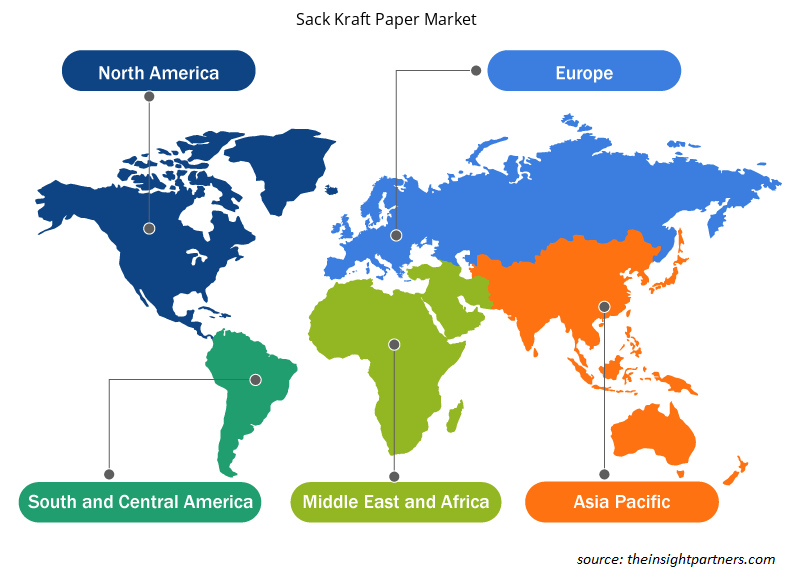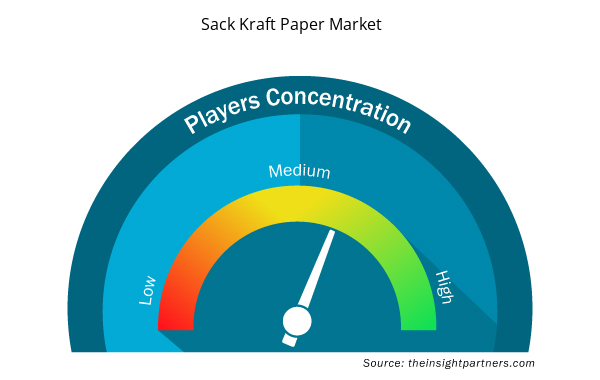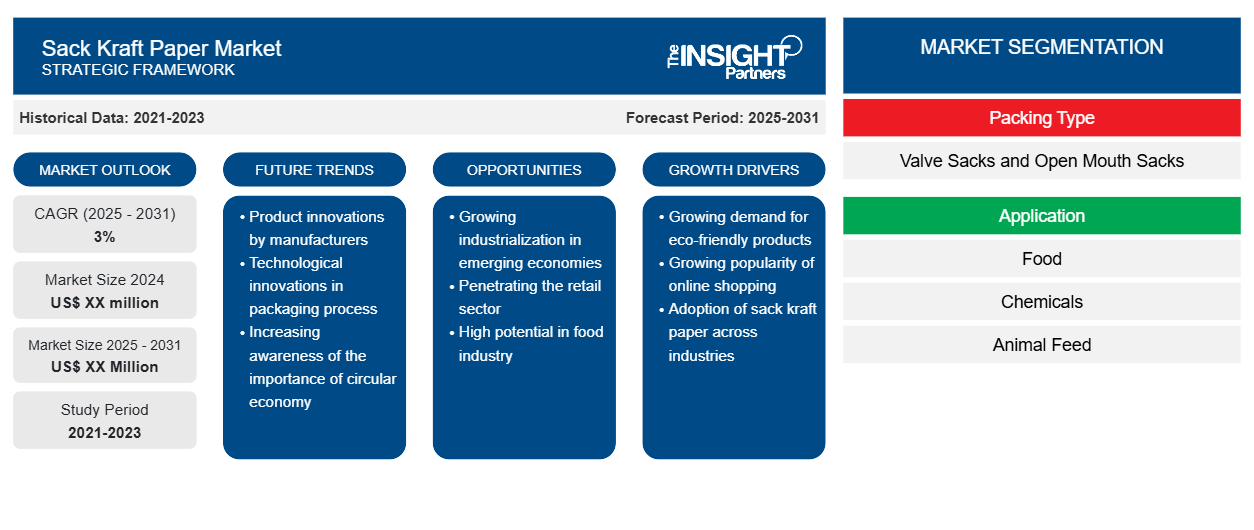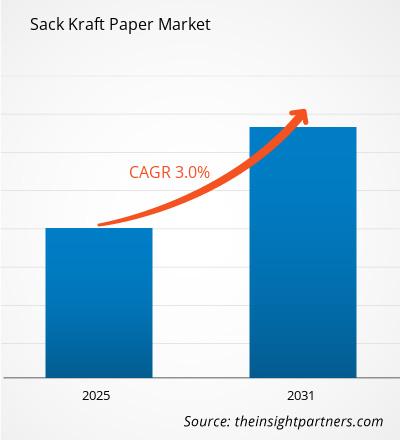Si prevede che il mercato della carta kraft per sacchi registrerà un CAGR del 3% dal 2023 al 2031, con una dimensione di mercato in espansione da XX milioni di dollari USA nel 2023 a XX milioni di dollari USA entro il 2031.
Il rapporto di mercato di sack kraft papet è segmentato in base al tipo di imballaggio (sacchi a valvola e sacchi a bocca aperta). Il mercato è segmentato in base all'applicazione (cibo, prodotti chimici, mangimi per animali, materiali da costruzione e altri). Le dimensioni del mercato e le previsioni a livello globale, regionale e nazionale per tutti i segmenti di mercato chiave sono coperte nell'ambito. Il rapporto offre il valore in USD per l'analisi, i segmenti, le regioni e i paesi di cui sopra. Il rapporto copre le tendenze di mercato, nonché le dinamiche di mercato come driver, vincoli e opportunità chiave. Il rapporto copre anche il panorama del settore e l'analisi della concorrenza che copre la concentrazione del mercato, l'analisi della mappa di calore, i principali attori e gli sviluppi recenti nel mercato.
Scopo del rapporto
Il report Sack Kraft Paper Market di The Insight Partners mira a descrivere il panorama attuale e la crescita futura, i principali fattori trainanti, le sfide e le opportunità. Ciò fornirà spunti a vari stakeholder aziendali, come:
- Fornitori/produttori di tecnologia: per comprendere le dinamiche di mercato in evoluzione e conoscere le potenziali opportunità di crescita, consentendo loro di prendere decisioni strategiche informate.
- Investitori: condurre un'analisi completa delle tendenze in merito al tasso di crescita del mercato, alle proiezioni finanziarie del mercato e alle opportunità esistenti lungo la catena del valore.
- Enti di regolamentazione: regolamentano le politiche e le attività di controllo sul mercato allo scopo di ridurre al minimo gli abusi, preservare la fiducia degli investitori e sostenere l'integrità e la stabilità del mercato.
Segmentazione del mercato della carta Kraft per sacchi
Tipo di imballaggio
- Sacchi a valvola e sacchi a bocca aperta
Applicazione
- Cibo
- Prodotti chimici
- Mangime per animali
- Materiale da costruzione
Personalizza questo report in base alle tue esigenze
Riceverai la personalizzazione gratuita di qualsiasi report, comprese parti di questo report, o analisi a livello nazionale, pacchetto dati Excel, oltre a usufruire di grandi offerte e sconti per start-up e università
- Scopri le principali tendenze di mercato in questo rapporto.Questo campione GRATUITO includerà analisi di dati che spaziano dalle tendenze di mercato alle stime e alle previsioni.
Fattori trainanti della crescita del mercato della carta kraft per sacchi
- Crescente domanda di prodotti eco-compatibili: l'attenzione incessante alla sostenibilità ha promosso la necessità di prodotti eco-compatibili come la carta kraft per sacchi. Per soddisfare la preoccupazione pubblica sull'inquinamento generato dalla plastica, qualsiasi imballaggio monouso includa, tutti i produttori, tranne pochi, hanno abbandonato l'uso di imballaggi e contenitori di marketing in plastica e hanno adottato la carta kraft, che è eminentemente adatta per la sua biodegradabilità e rinnovabilità da alberi coltivati a tale scopo. Settori come l'industria alimentare, l'agricoltura e l'edilizia si stanno orientando verso la carta più che mai, aumentando quindi il consumo di carta kraft per sacchi in vari prodotti come farina, zucchero e mangimi per animali.eco-friendly products: The unceasing focus on sustainability has promoted the need for eco-friendly products such as sack kraft paper. In order to satisfy the public concern about the pollution generated by plastic, whichever disposable packaging includes, all but a few manufacturers have dropped the use of plastic wrapping and marketing containers and adopted kraft paper, which is eminently suitable for its biodegradability and renewability from trees grown for the purpose. Sectors such as the food industry, agriculture, and construction are turning more towards paper than ever before, hence increasing the consumption of sack kraft paper in various products such as flour, sugar, and animal feed.
- Crescente popolarità dello shopping online: uno dei cambiamenti più significativi emersi dallo sviluppo di Internet è l'e-commerce e lo shopping online. È stato notato che, poiché sempre più persone utilizzano Internet per acquistare beni, è aumentata la necessità di mezzi efficaci ed ecologici per il materiale di imballaggio. Le istruzioni per la carta kraft per sacchi sono indicate laddove gli articoli della lingua sulla confezione possiedono una massa in natura o richiedono un imballaggio rigido. Lo sviluppo della vendita al dettaglio online, tra le altre cose, sarà accompagnato da una crescita della domanda di confezioni ecocompatibili, che dovrebbe aumentare l'utilizzo della carta kraft per sacchi da parte delle aziende di e-commerce.kraft paper instructions are stated where the articles of the language on the wrapper possess bulk in nature or require hard case packing. The development of online retail, amongst other things, will be accompanied by growth in demand for environmentally friendly packs, which is expected to increase the usage of sack kraft paper by e-commerce businesses.
- Adozione della carta kraft per sacchi in tutti i settori: la carta kraft per sacchi è stata utilizzata in molte applicazioni industriali grazie alla sua affidabile resistenza e durevolezza, nonché alla sua flessibilità. Viene spesso utilizzata per l'imballaggio di diverse materie prime alla rinfusa, ad esempio cemento, prodotti chimici e additivi alimentari. La necessità di carta kraft per sacchi va oltre i confini nazionali con il livello di industrializzazione in nazioni in via di sviluppo come Kenya, Zambia ecc. Materiali da costruzione più economici abbinati a nuove industrie chimiche sosterranno senza dubbio un aumento della domanda di carta kraft per sacchi. Oltre a ciò, nuovi progressi nei rivestimenti della carta e nelle tecniche di rinforzo le consentono di mirare a usi ancora più sofisticati dei prodotti, ampliandone ulteriormente la portata.kraft paper across industries: The sack kraft paper has been utilized in many industries applications due to its reliable strength and durability as well as its flexibility. It is often used for the packing of different raw materials in bulk, for instance cement, chemicals as well as food additives. The need for sack kraft paper goes beyond the domestic borders with the level of industrialization in developing nations like Kenya, Zambia etc. Cheaper building materials coupled with new chemical industries will no doubt support an increase in the demand for sack kraft paper. In addition to this, new advances in paper coatings and strengthening techniques are enabling it to target even more high-end uses of the products, growing its scope further.
Tendenze future del mercato della carta kraft in sacchi
- Innovazioni di prodotto da parte dei produttori: per tenere il passo con le richieste di applicazioni più diversificate che probabilmente comprenderanno imballaggi di prodotti liquidi, chimici o persino deperibili, i fornitori stanno ideando più frequentemente carte kraft per sacchi multistrato e/o con rivestimento barriera. Queste caratteristiche offrono la versatilità della carta kraft per sacchi convenzionale migliorata con capacità aggiuntive di resistenza all'acqua, all'olio e allo strappo. Si prevede che tale crescente domanda darà più spazio all'uso della carta kraft per sacchi in settori quali alimenti e bevande, prodotti farmaceutici e chimici; quindi, saranno sviluppati prodotti più complessi.kraft papers more frequently. These features offer the versatility of conventional sack kraft paper enhanced with additional water, oil, and tear-resistant capabilities. Such growing demand is expected to give more space for the use of sack kraft paper in sectors such as food and beverage, pharmaceuticals, and chemicals; hence, more complex products will be developed.
- Innovazioni tecnologiche nel processo di imballaggio: le tecnologie per la stampa digitale sui materiali di riempimento stanno cambiando il modo in cui i marchi utilizzano l'imballaggio. Le aziende moderne sono in grado di imporre splendidi motivi, loghi trapuntati e testi pubblicitari su carte Kraft per sacchi grazie alla crescita della stampa digitale su carta Kraft. Questo miglioramento non solo abbellisce l'imballaggio per i prodotti decorati, ma semplifica anche la produzione di piccole tirature di imballaggi decorativi. L'impennata dell'e-commerce e la crescente attrattiva verso una grande personalizzazione richiederanno la tecnologia di stampa digitale su carta Kraft per sacchi come ingranaggio nella strategia di marketing efficace.
- Maggiore consapevolezza dell'importanza dell'economia circolare: la crescente attenzione ai concetti di economia circolare praticati in cui i materiali vengono riutilizzati anziché sprecati influenzerà il mercato della carta kraft per sacchi. I fornitori stanno sempre più implementando una strategia di spreco minimo organizzando attività di riciclaggio e consumando fibre di carta riprocessate. Anche sviluppi come rivestimenti compostabili e additivi di origine biologica sono in aumento. Le aziende in futuro, poiché i consumatori si sposteranno in modo più sostenibile in tutte le loro operazioni, si concentreranno maggiormente sulla creazione di catene di fornitura.
Opportunità di mercato per la carta Kraft in sacchi
- Crescente industrializzazione nelle economie emergenti: la crescita di regioni come Asia-Pacifico, America Latina e Africa, in relazione al processo di industrializzazione, comporterà un aumento della necessità di materiali di imballaggio, in particolare carta kraft per sacchi, tra gli altri. Queste regioni stanno vivendo una rapida urbanizzazione e un aumento della popolazione della classe media che a sua volta sta aumentando la necessità di imballaggi al dettaglio e industriali. Oltre a ciò, a causa delle attività di costruzione in queste aree e del crescente consumismo, esiste un immenso potenziale di penetrazione del mercato per i produttori di carta kraft per sacchi per aumentare le dimensioni del loro mercato.
- Penetrazione nel settore della vendita al dettaglio: il settore della vendita al dettaglio presenta un potenziale considerevole per la crescita del mercato della carta kraft per sacchi, dovuto al crescente utilizzo di sacchi pieni di carta in sostituzione di quelli pieni di plastica. Un movimento che sottolinea l'importanza di imballaggi sostenibili per i rivenditori sta guadagnando terreno e, al giorno d'oggi, l'uso di sacchetti di carta kraft per sacchi è giustamente considerato una risorsa verde e rinnovabile. L'attuazione di misure per vietare l'uso della plastica da parte della maggior parte dei governi vedrà la distribuzione all'ingrosso di questo materiale ecologico, che probabilmente sarà la carta kraft per sacchi, in particolare nei negozi al dettaglio che vendono generi alimentari, regali e vestiti.
- Elevato potenziale nell'industria alimentare: l'industria alimentare e delle bevande ha un elevato potenziale, che può essere sfruttato con la carta kraft per sacchi, soprattutto con la crescita del numero di consumatori alla ricerca di opzioni naturali e biologiche. Prodotti confezionati come farina, riso, noodles e persino alcuni alimenti per animali che sono alimenti secchi sono ampiamente racchiusi in carta kraft perché è sia resistente che amica di madre natura. In relazione ai prodotti che di solito vengono forniti in contenitori di plastica, come patatine e prodotti pronti al consumo, c'è un mercato in crescita per la carta kraft per sacchi. A causa della continua proliferazione di consumatori attenti all'ambiente, il settore alimentare e delle bevande rimarrà un mercato efficace.
Approfondimenti regionali sul mercato della carta kraft in sacchi
Le tendenze regionali e i fattori che influenzano il mercato della carta kraft per sacchi durante il periodo di previsione sono stati ampiamente spiegati dagli analisti di Insight Partners. Questa sezione discute anche i segmenti e la geografia del mercato della carta kraft per sacchi in Nord America, Europa, Asia Pacifico, Medio Oriente e Africa e Sud e Centro America.

- Ottieni i dati specifici regionali per il mercato della carta kraft in sacchi
Ambito del rapporto di mercato sulla carta kraft in sacchi
| Attributo del report | Dettagli |
|---|---|
| Dimensioni del mercato nel 2023 | XX milioni di dollari USA |
| Dimensioni del mercato entro il 2031 | XX milioni di dollari USA |
| CAGR globale (2023-2031) | 3% |
| Dati storici | 2021-2022 |
| Periodo di previsione | 2024-2031 |
| Segmenti coperti | Per tipo di imballaggio
|
| Regioni e Paesi coperti | America del Nord
|
| Leader di mercato e profili aziendali chiave |
|
Densità dei giocatori del mercato della carta Kraft in sacchi: comprendere il suo impatto sulle dinamiche aziendali
Il mercato Sack Kraft Paper Market sta crescendo rapidamente, spinto dalla crescente domanda degli utenti finali dovuta a fattori quali l'evoluzione delle preferenze dei consumatori, i progressi tecnologici e una maggiore consapevolezza dei vantaggi del prodotto. Con l'aumento della domanda, le aziende stanno ampliando le loro offerte, innovando per soddisfare le esigenze dei consumatori e capitalizzando sulle tendenze emergenti, il che alimenta ulteriormente la crescita del mercato.
La densità degli operatori di mercato si riferisce alla distribuzione di aziende o società che operano in un particolare mercato o settore. Indica quanti concorrenti (operatori di mercato) sono presenti in un dato spazio di mercato in relazione alle sue dimensioni o al valore di mercato totale.
Le principali aziende che operano nel mercato della carta Kraft per sacchi sono:
- BillerudKorsnäs
- Società Canfor
- Gruppo Gascogne
- Società di carta internazionale
- Società di carta e imballaggio KapStone
Disclaimer : le aziende elencate sopra non sono classificate secondo un ordine particolare.

- Ottieni una panoramica dei principali attori del mercato della carta kraft per sacchi
Punti chiave di vendita
- Copertura completa: il rapporto esamina in modo completo i prodotti, i servizi, le tipologie e gli utenti finali del mercato della carta kraft per sacchi, offrendo una panoramica olistica.
- Analisi degli esperti: il rapporto è compilato sulla base della conoscenza approfondita di esperti e analisti del settore.
- Informazioni aggiornate: il rapporto garantisce la pertinenza aziendale grazie alla copertura di informazioni recenti e tendenze nei dati.
- Opzioni di personalizzazione: questo report può essere personalizzato per soddisfare le esigenze specifiche del cliente e adattarsi in modo appropriato alle strategie aziendali.
Il rapporto di ricerca sul mercato della carta kraft per sacchi può quindi aiutare a guidare il percorso di decodificazione e comprensione dello scenario del settore e delle prospettive di crescita. Sebbene possano esserci alcune preoccupazioni valide, i vantaggi complessivi di questo rapporto tendono a superare gli svantaggi.
- Analisi storica (2 anni), anno base, previsione (7 anni) con CAGR
- Analisi PEST e SWOT
- Valore/volume delle dimensioni del mercato - Globale, regionale, nazionale
- Industria e panorama competitivo
- Set di dati Excel


- Sodium Bicarbonate Market
- Carbon Fiber Market
- Mail Order Pharmacy Market
- Photo Editing Software Market
- Medical Second Opinion Market
- Visualization and 3D Rendering Software Market
- Educational Furniture Market
- Single-Use Negative Pressure Wound Therapy Devices Market
- Fertilizer Additives Market
- Dried Blueberry Market

Report Coverage
Revenue forecast, Company Analysis, Industry landscape, Growth factors, and Trends

Segment Covered
This text is related
to segments covered.

Regional Scope
North America, Europe, Asia Pacific, Middle East & Africa, South & Central America

Country Scope
This text is related
to country scope.
Domande frequenti
Shift toward multilayer and barrier-coated sack kraft paper is expected to be the key market trends.
Based on application, the food segment is expected to witness the fastest growth during the forecast period.
Based on geography, Asia Pacific held the largest share of the sack kraft paper market due to the strong growth of the food and animal feed industry in the region.
Increasing demand for sustainable packaging is driving the market growth.
Nordic Paper, Smurfit Kappa, Mondi PLC, BillerudKorsnäs, Gascogne Group, Papiersackfabrik Alfred Rockenfeller GmbH, Segezha-Group, Fiorini Packaging SpA, Saccarta S.p.a., and Jonsac AB are the key players operating in the sack kraft paper market.
The Sack Kraft Paper Market is estimated to witness a CAGR of 3% from 2023 to 2031
Trends and growth analysis reports related to Chemicals and Materials : READ MORE..
1. BillerudKorsnäs
2. Canfor Corporation
3. Gascogne Group
4. International Paper Company
5. KapStone Paper and Packaging Corporation
6. Mondi PLC
7. Natron-Hayat d.o.o.
8. Nordic Paper
9. Segezha Group
10. WestRock Company
The Insight Partners performs research in 4 major stages: Data Collection & Secondary Research, Primary Research, Data Analysis and Data Triangulation & Final Review.
- Data Collection and Secondary Research:
As a market research and consulting firm operating from a decade, we have published and advised several client across the globe. First step for any study will start with an assessment of currently available data and insights from existing reports. Further, historical and current market information is collected from Investor Presentations, Annual Reports, SEC Filings, etc., and other information related to company’s performance and market positioning are gathered from Paid Databases (Factiva, Hoovers, and Reuters) and various other publications available in public domain.
Several associations trade associates, technical forums, institutes, societies and organization are accessed to gain technical as well as market related insights through their publications such as research papers, blogs and press releases related to the studies are referred to get cues about the market. Further, white papers, journals, magazines, and other news articles published in last 3 years are scrutinized and analyzed to understand the current market trends.
- Primary Research:
The primarily interview analysis comprise of data obtained from industry participants interview and answers to survey questions gathered by in-house primary team.
For primary research, interviews are conducted with industry experts/CEOs/Marketing Managers/VPs/Subject Matter Experts from both demand and supply side to get a 360-degree view of the market. The primary team conducts several interviews based on the complexity of the markets to understand the various market trends and dynamics which makes research more credible and precise.
A typical research interview fulfils the following functions:
- Provides first-hand information on the market size, market trends, growth trends, competitive landscape, and outlook
- Validates and strengthens in-house secondary research findings
- Develops the analysis team’s expertise and market understanding
Primary research involves email interactions and telephone interviews for each market, category, segment, and sub-segment across geographies. The participants who typically take part in such a process include, but are not limited to:
- Industry participants: VPs, business development managers, market intelligence managers and national sales managers
- Outside experts: Valuation experts, research analysts and key opinion leaders specializing in the electronics and semiconductor industry.
Below is the breakup of our primary respondents by company, designation, and region:

Once we receive the confirmation from primary research sources or primary respondents, we finalize the base year market estimation and forecast the data as per the macroeconomic and microeconomic factors assessed during data collection.
- Data Analysis:
Once data is validated through both secondary as well as primary respondents, we finalize the market estimations by hypothesis formulation and factor analysis at regional and country level.
- Macro-Economic Factor Analysis:
We analyse macroeconomic indicators such the gross domestic product (GDP), increase in the demand for goods and services across industries, technological advancement, regional economic growth, governmental policies, the influence of COVID-19, PEST analysis, and other aspects. This analysis aids in setting benchmarks for various nations/regions and approximating market splits. Additionally, the general trend of the aforementioned components aid in determining the market's development possibilities.
- Country Level Data:
Various factors that are especially aligned to the country are taken into account to determine the market size for a certain area and country, including the presence of vendors, such as headquarters and offices, the country's GDP, demand patterns, and industry growth. To comprehend the market dynamics for the nation, a number of growth variables, inhibitors, application areas, and current market trends are researched. The aforementioned elements aid in determining the country's overall market's growth potential.
- Company Profile:
The “Table of Contents” is formulated by listing and analyzing more than 25 - 30 companies operating in the market ecosystem across geographies. However, we profile only 10 companies as a standard practice in our syndicate reports. These 10 companies comprise leading, emerging, and regional players. Nonetheless, our analysis is not restricted to the 10 listed companies, we also analyze other companies present in the market to develop a holistic view and understand the prevailing trends. The “Company Profiles” section in the report covers key facts, business description, products & services, financial information, SWOT analysis, and key developments. The financial information presented is extracted from the annual reports and official documents of the publicly listed companies. Upon collecting the information for the sections of respective companies, we verify them via various primary sources and then compile the data in respective company profiles. The company level information helps us in deriving the base number as well as in forecasting the market size.
- Developing Base Number:
Aggregation of sales statistics (2020-2022) and macro-economic factor, and other secondary and primary research insights are utilized to arrive at base number and related market shares for 2022. The data gaps are identified in this step and relevant market data is analyzed, collected from paid primary interviews or databases. On finalizing the base year market size, forecasts are developed on the basis of macro-economic, industry and market growth factors and company level analysis.
- Data Triangulation and Final Review:
The market findings and base year market size calculations are validated from supply as well as demand side. Demand side validations are based on macro-economic factor analysis and benchmarks for respective regions and countries. In case of supply side validations, revenues of major companies are estimated (in case not available) based on industry benchmark, approximate number of employees, product portfolio, and primary interviews revenues are gathered. Further revenue from target product/service segment is assessed to avoid overshooting of market statistics. In case of heavy deviations between supply and demand side values, all thes steps are repeated to achieve synchronization.
We follow an iterative model, wherein we share our research findings with Subject Matter Experts (SME’s) and Key Opinion Leaders (KOLs) until consensus view of the market is not formulated – this model negates any drastic deviation in the opinions of experts. Only validated and universally acceptable research findings are quoted in our reports.
We have important check points that we use to validate our research findings – which we call – data triangulation, where we validate the information, we generate from secondary sources with primary interviews and then we re-validate with our internal data bases and Subject matter experts. This comprehensive model enables us to deliver high quality, reliable data in shortest possible time.


 Ottieni un campione gratuito per questo repot
Ottieni un campione gratuito per questo repot